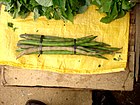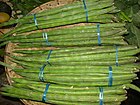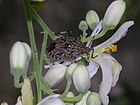Note: This is a project under development. The articles on this wiki are just being initiated and broadly incomplete. You can Help creating new pages.
Moringa oleifera - Drumstick
Moringa oleifera is the most widely cultivated species of the genus Moringa, which is the only genus in the family Moringaceae.
Uses
Parts Used
Chemical Composition
Investigation of the carotenoid contents from the leaves, flowers and fruits of eight M. oleifera cultivars from India yielded luteoxanthin, lutein, zeaxanthin, and β-carotene[1]
Common names
| Language | Common name |
|---|---|
| Kannada | Nuggekayee |
| Hindi | Sahjan |
| Malayalam | Muringa |
| Tamil | Murungai Maram |
| Telugu | Munagachettu |
| Marathi | NA |
| Gujarathi | NA |
| Punjabi | NA |
| Kashmiri | NA |
| Sanskrit | |
| English | Drumstick |
Properties
Reference: Dravya - Substance, Rasa - Taste, Guna - Qualities, Veerya - Potency, Vipaka - Post-digesion effect, Karma - Pharmacological activity, Prabhava - Therepeutics.
Dravya
Rasa
Tikta (Bitter), Katu (Pungent)
Guna
Laghu (Light), Ruksha (Dry), Tikshna (Sharp)
Veerya
Ushna (Hot)
Vipaka
Katu (Pungent)
Karma
Kapha, Vata
Prabhava
Habit
Identification
Leaf
| Kind | Shape | Feature |
|---|---|---|
| Simple | Tri-pinnate | Leaf Arrangement is Alternate-spiral and Leaf Shape is Ovate or elliptic |
Flower
| Type | Size | Color and composition | Stamen | More information |
|---|---|---|---|---|
| Unisexual | flower borne on a false pedicel 7-15 mm | white to cream | 5 | In axillary, divaricate panicles; white. Flowering throughout the year. |
Fruit
| Type | Size | Mass | Appearance | Seeds | More information |
|---|---|---|---|---|---|
| elongate | torulose capsule, angled, longitudinally 3-valved; seeds many, 3 angled, 3 winged. Fruiting throughout the year | Bark corky grey | many seeds | {{{6}}} |
Other features
List of Ayurvedic medicine in which the herb is used
Where to get the saplings
Mode of Propagation
How to plant/cultivate
Moringa seeds can be planted directly where intended to be grown. No pretreatment is required. Cuttings take root very easily and even large branches can be planted and they will sprout. [4]
Commonly seen growing in areas
Photo Gallery
References
External Links
- Ayurvedic Herbs known to be helpful to treat Arthritis
- Ayurvedic Herbs known to be helpful to treat Joint pain
- Ayurvedic Herbs known to be helpful to treat Asthma
- Ayurvedic Herbs known to be helpful to treat Cancer
- Ayurvedic Herbs known to be helpful to treat Diabetes
- Ayurvedic Herbs known to be helpful to treat Constipation
- Ayurvedic Herbs known to be helpful to treat Epilepsy
- Ayurvedic Herbs known to be helpful to treat Diarrhea
- Ayurvedic Herbs known to be helpful to treat Stomachache
- Herbs with Leaves used in medicine
- Herbs with Flowers used in medicine
- Herbs with Pods used in medicine
- Herbs with Seeds used in medicine
- Herbs with common name in Kannada
- Herbs with common name in Hindi
- Herbs with common name in Malayalam
- Herbs with common name in Tamil
- Herbs with common name in Telugu
- Herbs with common name in English
- Habit - Small tree
- Index of Plants which can be propagated by Seeds
- Index of Plants which can be propagated by Cuttings
- Herbs that are commonly seen in the region of Tropical area
- Herbs that are commonly seen in the region of Subtropical area
- Herbs that are commonly seen in the region of Equatorial climate areas
- Herbs
- Ayurvedic herbs that don't have seed photos
- Moringaceae





